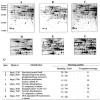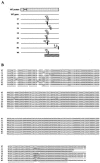Resistance to antimicrobial peptides and stress response in Mycoplasma pulmonis
- PMID: 16189093
- PMCID: PMC1251518
- DOI: 10.1128/AAC.49.10.4154-4165.2005
Resistance to antimicrobial peptides and stress response in Mycoplasma pulmonis
Abstract
Antimicrobial peptides are widely distributed in nature, and in vertebrates, they play a key function in the innate immune defense system. It is generally agreed that these molecules may provide new antibiotics with therapeutic value. However, there are still many unsolved questions regarding the mechanisms underlying their antimicrobial activity as well as the mechanisms of resistance evolved by microorganisms against these molecules. The second point was addressed in this study. After determining the activity of 10 antimicrobial peptides against Mycoplasma pulmonis, a murine respiratory pathogen, the development of resistance was investigated. Following in vitro selection using subinhibitory concentrations of peptides, clones of this bacterium showing increased resistance to melittin or gramicidin D were obtained. For some of the clones, a cross-resistance was observed between these two peptides, in spite of their deep structural differences, and also with tetracycline. A proteomic analysis suggested that the stress response in these clones was constitutively activated, and this was confirmed by finding mutations in the hrcA gene; in mycoplasmas, bacteria which lack alternative sigma factors, the HrcA protein is supposed to play a key role as a negative regulator of heat shock proteins. By complementation of the hrcA mutants with the wild-type gene, the initial MICs of melittin and gramicidin D decreased to values close to the initial ones. This indicates that the resistance of M. pulmonis to these two antimicrobial peptides could result from a stress response involving HrcA-regulated genes.
Figures




Similar articles
-
Biofilms protect Mycoplasma pulmonis cells from lytic effects of complement and gramicidin.Infect Immun. 2007 Aug;75(8):3696-9. doi: 10.1128/IAI.00440-07. Epub 2007 May 21. Infect Immun. 2007. PMID: 17517864 Free PMC article.
-
Activities of antimicrobial peptides and synergy with enrofloxacin against Mycoplasma pulmonis.Antimicrob Agents Chemother. 2007 Feb;51(2):468-74. doi: 10.1128/AAC.01030-06. Epub 2006 Nov 13. Antimicrob Agents Chemother. 2007. PMID: 17101680 Free PMC article.
-
Interaction of cationic antimicrobial peptides with Mycoplasma pulmonis.FEBS Lett. 2013 Oct 11;587(20):3321-6. doi: 10.1016/j.febslet.2013.08.016. Epub 2013 Aug 28. FEBS Lett. 2013. PMID: 23994526
-
Gramicidin S and polymyxins: the revival of cationic cyclic peptide antibiotics.Cell Mol Life Sci. 2009 Dec;66(23):3821-6. doi: 10.1007/s00018-009-0129-9. Epub 2009 Aug 23. Cell Mol Life Sci. 2009. PMID: 19701717 Free PMC article. Review.
-
Design of host defence peptides for antimicrobial and immunity enhancing activities.Comb Chem High Throughput Screen. 2005 May;8(3):257-72. doi: 10.2174/1386207053764558. Comb Chem High Throughput Screen. 2005. PMID: 15892627 Review.
Cited by
-
Adaptation of Mycoplasmas to Antimicrobial Peptides: Development of Melittin Resistance in Acholeplasma laidlawii Is Associated with Changes in Genomic and Proteomic Profiles and in Virulence.Dokl Biochem Biophys. 2020 Nov;495(1):300-303. doi: 10.1134/S1607672920060034. Epub 2020 Dec 25. Dokl Biochem Biophys. 2020. PMID: 33368039
-
Extracellular Proteins of Mycoplasma synoviae.ISRN Vet Sci. 2012 Sep 6;2012:802308. doi: 10.5402/2012/802308. Print 2012. ISRN Vet Sci. 2012. PMID: 23762591 Free PMC article.
-
Biofilm formation of Streptococcus equi ssp. zooepidemicus and comparative proteomic analysis of biofilm and planktonic cells.Curr Microbiol. 2014 Sep;69(3):227-33. doi: 10.1007/s00284-014-0574-z. Epub 2014 Apr 3. Curr Microbiol. 2014. PMID: 24696150
-
Biofilms protect Mycoplasma pulmonis cells from lytic effects of complement and gramicidin.Infect Immun. 2007 Aug;75(8):3696-9. doi: 10.1128/IAI.00440-07. Epub 2007 May 21. Infect Immun. 2007. PMID: 17517864 Free PMC article.
-
Insect Antimicrobial Peptide Complexes Prevent Resistance Development in Bacteria.PLoS One. 2015 Jul 15;10(7):e0130788. doi: 10.1371/journal.pone.0130788. eCollection 2015. PLoS One. 2015. PMID: 26177023 Free PMC article.
References
-
- Andres, E., and J. L. Dimarcq. 2004. Cationic antimicrobial peptides: update of clinical development. J. Intern. Med. 255:519-520. - PubMed
-
- Bals, R., and P. S. Hiemstra. 2004. Innate immunity in the lung: how epithelial cells fight against respiratory pathogens. Eur. Respir. J. 23:327-333. - PubMed
-
- Bengoechea, J. A., and M. Skurnik. 2000. Temperature-regulated efflux pump/potassium antiporter system mediates resistance to cationic antimicrobial peptides in Yersinia. Mol. Microbiol. 37:67-80. - PubMed
Publication types
MeSH terms
Substances
LinkOut - more resources
Full Text Sources
Other Literature Sources
Medical

